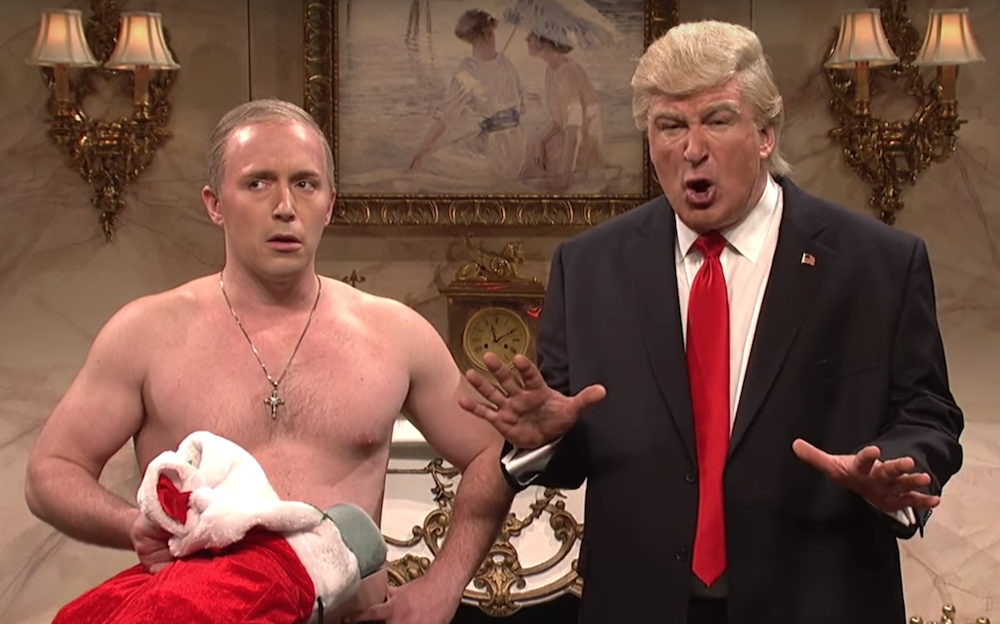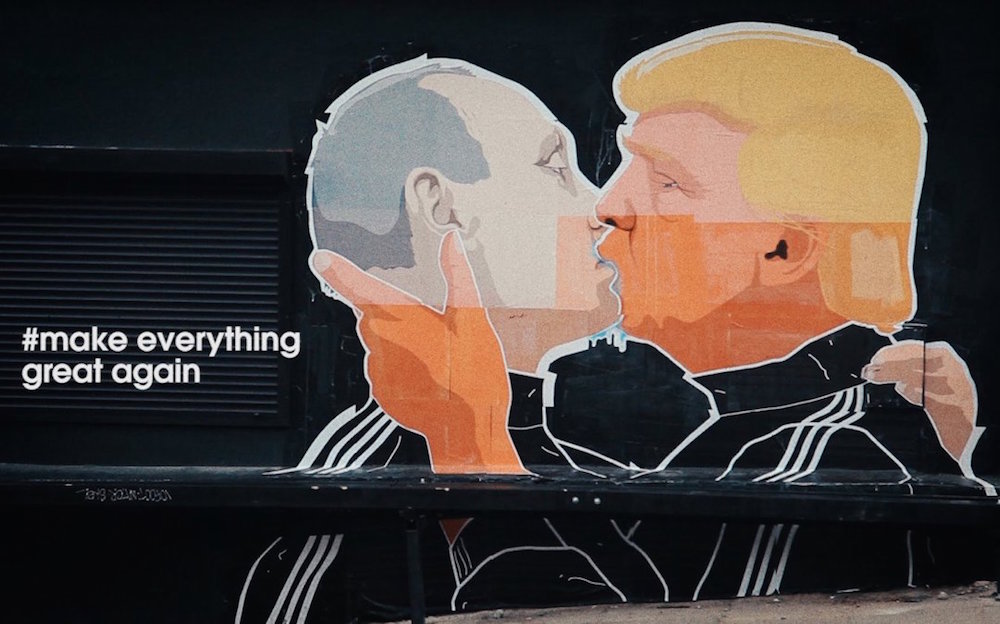Sealed with a kiss: from t.A.T.u. to Trump, do Western portrayals of ‘gay’ Russia miss the point?
From Dmitri Vrubel’s famous Berlin Wall mural to comedic portrayals of Putin and Trump, projections of Russian ‘gays’ abound in the West. But do they miss the point?
“You kiss me,” the old song goes, “and with your kiss my life begins”. Those teenage kisses get written into us, especially the first ones. One of my most meaningful kisses happened when I was barely 16. Nobody kissed me, though. In fact, I didn’t even see the kiss; that was somewhat the point. It was between two girls, a few years older than me — members of the Russian pop duo t.A.T.u, a synthesised crypto-lesbian couple whose appearance in British mainstream culture was fueled by a publicity campaign that teased out the controversy of both their age and supposed orientation. That controversy reached its peak when music show Top of the Pops allegedly censored an on-screen kiss during a performance of their breakout hit All The Things She Said. The same evening I fired off a painfully sincere email of complaint to the programme: my first conscious bit of gay rights activism.
All The Things She Said became a staple of the basic, cheerful gay bars I visited in my 20s, and it’s still a great song, although by then I’d flush thinking how earnestly I’d believed the cheap sexual publicity stunt. In 2014, one of the vocalists, Yulia Volkova (a married bisexual), was asked on Ukrainian TV if she would admonish her own son for being gay. “Yes,” she replied, “I would condemn him because I believe that a real man must be a real man… A man has no right to be a fag.” This was in a year when the liberal media in the UK and USA was rife with comment and coverage of LGBTQ issues in Russia. In the early spring, the Winter Olympics were held in the Russian city of Sochi, providing a focus for political protest against the Putin administration’s “anti-gay law” of the previous year, as well as increasing concerns about the treatment of LGBTQ people in Russia in general.
Russia became public enemy number #1 amongst the liberal gay community, bringing out a generalised Russophobic sentiment that played on Cold War era tropes in much the same way as has been in evidence since the 2016 US election. We have always been trendsetters. Arch-liberal gay writer Dan Savage called for the boycott of Soviet-developed Stolichnaya vodka, despite the fact the brand is based in Luxembourg, and is a vocal supporter of LGBT rights organisations in the US, Europe and Russia. No matter, said Savage, “Stoli is a Russian vodka.” Pro-gay solidarity protests were heavy on Soviet-era political imagery, with a number of design contests to produce campaign posters for the Sochi Olympics featuring subverted Stalinist and post-Stalinist era posters, with the aid of rainbow flags and pro-gay slogans.
Russia became public enemy number #1 amongst the liberal gay community, bringing out a generalised Russophobic sentiment that played on Cold War era tropes
Another prominent placard featured a portrait of Putin photoshopped to make him look heavily made-up, in fake eyelashes and blusher. It’s long been a trope of anti-Putin commentary: his fondness for playing up to supposed masculine ideals has included him being frequently photographed topless, fishing and horse-riding. This ostentatious masculinist posing has been read in the west as intrinsically camp, with critics subverting this self-image by suggesting that this visual spin has fallen short and exposed a man who is deeply insecure with his masculinity, or even sexual orientation. That logic, however, might well suggest more about our own Western readings of the relationship between machismo, homosexuality and gender norms than it does about Putin’s psychological profile.
While comedy panel shows and clickbait journalism make the most of the supposed homoeroticism of his public image, this criticism revolves around the idea that homosexuality is, either in its absence or surplus, a failure of masculinity. There is, of course, no evidence that Putin is homosexual; instead, the humour is derived from his failure to convincingly reproduce Western gender norms. The made-up Putin is a figure of fun — to wear cosmetics as a man is judged to be ridiculous or perverse — while the overly-masculine postures are a sign that Putin is “trying too hard”, in order to conceal his true nature (a homosexual). Whether he’s in drag, or dragging up as a rough woodsman, the implication is the same: Putin is gay, and that’s a cause for mockery. The logic is not only deeply homophobic, it’s also terribly straight, making the homophobia he exhibits an expression of his own unacknowledged homosexuality (for which there is no evidence at all), rather than a product of a low-level homophobia that exists in the West. This is either an issue with backwards Russians, or an issue with closeted gays, the argument goes. Either way, it’s nothing to do with us.
There is, of course, no evidence that Putin is homosexual; instead, the humour is derived from his failure to convincingly reproduce Western gender norms
Putin’s drag image is not the only manifestation of this trend. Even before President Trump’s inauguration in January 2017, and the subsequent investigation into collusion between the Trump campaign and the Russian administration, the relationship between the US mogul and the Russian president was frequently depicted as intrinsically romantic, even sexual. On US comedy show Saturday Night Live a topless Putin (Beck Bennett), described as Trump’s “long-time crush”, is seen kissing the President (Alec Baldwin), who calls him “sweetie”. On Valentine’s Day of the same year, a huge projection of the two figures in a naked embrace, with Trump seemingly pregnant, appeared on a Brooklyn building (what later turned out to be a marketing stunt for mobile dating app). And in Lithuania in May, a mural appeared on the side of a restaurant depicting the two leaders kissing passionately, which went viral on social media in the US.
That image, of course, is a parody of the famous 1990 mural by Russian artist Dmitri Vrubel, My God, Help Me to Survive This Deadly Love. Painted on the Berlin Wall in the short period between the fall of the wall and the eventual collapse of the GDR, the mural depicts Leonid Brezhnev and Erich Hönecker exchanging a kiss to mark the signing of an economic pact between the USSR and the GDR in 1979, taken from a photo by Régis Bossu. It’s not the first parody of the mural; clothing company Benetton produced a series of images based on the image in 2011, including a version featuring Barack Obama and Hugo Chavez, whilst a Kazakh advertising agency was fined in 2014 for producing an advert depicting Kazakh composer Kurmangazy Sagyrbayuly kissing Alexander Pushkin.
These copies, however — and especially the depiction of Trump and Putin, later emulated in the UK in a version featuring Trump and Boris Johnson — miss the satirical bite of the original. Like the reception of Putin’s self-image of masculinity, they impose Western sexual and gender norms onto an entirely different gesture, and draw their humour only from a simplistic, homophobic reading.
Vrubel’s original mural operates from the tension in the diplomatic relations between the two nations, and the gesture of the original kiss — not, by any stretch of the imagination, one loaded with homosexual subtext, but rather a “socialist fraternal kiss”. The socialist fraternal kiss, a diplomatic greeting that evolved out of the Communist movement, symbolised something more than a handshake. Usually comprised of three kisses to the cheek, a kiss on the mouth functioned as an important sign of political brotherhood. It was the implication of a fraternal bond that would lead to the GDR’s demise — and the suffering of its citizens — that gave Vrubel’s painting its satirical edge. Implying the GDR’s subservient relationship to the USSR, it symbolised a form of embrace that one cannot escape from, and an imbalance between the two partners as nations, rather than being a cheap jibe at the idea that both partners are men. The title, painted above and below the image, activates the image in an ironic form, questioning whether the relationship between the two nations, unlike that of the two statesmen, could ever be considered truly “fraternal”.
The same cannot be said for the remixes of Vrubel’s work, where the humour is derived from portraying the allegedly close political relationships between Trump and Putin, or Trump and Johnson, as romantic; and what could be funnier, or more humiliating for its subjects, than to depict the two men as gay lovers. Just as the attempts to laugh at Putin’s macho photoshoots as implicitly gay fail to understand the potential for different cultural relationships to both masculinity and homosociality, so these new murals flatten the cultural meaning of the kiss. It’s ironic that in their attempts to criticise Putin for his homophobic policies, such criticisms so frequently rest upon mobilising homophobic stereotypes — not least the weakness and abjection of gay men, and their unsuitability as political leaders — that are still widespread and largely uncontested in the West.
Text: Huw Lemmey







